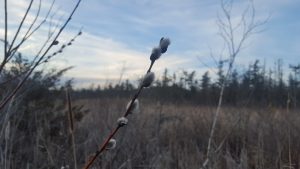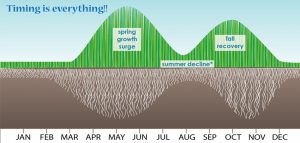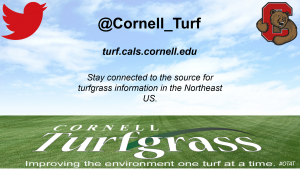“Springtime is the land awakening. The March winds are the morning yawn.” – Quoted by Lewis Grizzard in Kathy Sue Loudermilk, I Love You

Spring is slowly unfurling. And in the spring a young man’s fancy lightly turns to thoughts of… turf maintenance. Photo: Joellen Lampman
The first athletic field question of the year has arrived – and it has to do with the Child Safe Playing Fields Act. (Since its full implementation in 2011, there are still many questions about the law. We tried to address some of the more common ones in a previous blog post.) This week’s question was in regards to fertilizer and if there were any restriction under the law.
The answer is no, although a combined fertilizer and pesticide product (often referred to as weed and feed) is covered under the Child Safe Playing Fields Act. Fertilizer use, however, does fall under the NYS Nutrient Runoff Law, which prohibits:
- Applying fertilizer containing nitrogen, phosphorus, or potassium between December 1 and April 1 (Nassau and Suffolk County have their own local laws restricting application dates)
- Applying fertilizer containing phosphorus unless you are establishing a new lawn or a soil test shows the need for phosphorus
- Applying fertilizer within 20 feet of a water body (there are some caveats – see DEC website)
- Leaving fertilizer on impervious surfaces such as sidewalks, parking lots, or driveways (fertilizer must be swept up, not washed off with water)
Thus ends the legal part of the blog.
And now on to why we would talk about fertilizer on a pest management blog. Healthy turfgrass is the best preventive against turf pests. Dense stands leave little room for weed seeds to germinate. Extensive roots can withstand some insect feeding without impacting turf quality. Proper fertilization provides your grass with the proper nutrients for growth and recovery.
So what is the minimum that should be done now to produce pest resistant turfgrass on fields that are used year round?

Heavy spring fertilizer applications lead to excessive shoot and leaf growth and poor root growth. This leaves turf less likely to handle harsh summer conditions.
- Fertilizing – After the turf greens up and ensuring that you are able to apply fertilizer legally (April 1st for most of NY), apply ½ pound of 50% water soluble nitrogen per 1,000 sq. ft. in April and ½ pound of 50% water soluble nitrogen or 100% organic nitrogen source in mid to late May. Note that spring applications are lighter than late summer and fall fertilization rates.
- Mowing – If you haven’t already, sharpen those blades. Sharp blades reduces both injury to the turf blades as they are being cut and fuel usage. Once the grass is growing, mow as frequently as your schedule allows and as high as the sport allows. Mowing increases shoot density by increasing tillering (stems that develop from the crown of the parent plant). Dense turf leaves less room for weeds to propagate.
- Overseeding -Seed perennial rye at 2 pounds per 1,000 sq. ft. weekly in high-use areas. With snow in the forecast, you may want to consider dormant overseeding now.
What if I can do more than the minimum?
- Watering – According to the Northeast Drought Update, “27% of the Northeast in a drought and 20% of the region is abnormally dry”. Once it starts growing, turf needs about 1” of water per week. You can help determine irrigation need by referring to ForeCast: Weather for the Turf Industry Irrigation Information.
- Fertilizing – Conduct a soil test to see if other nutrients are needed in addition to the nitrogen.
- Cultivating – Concentrating on high-use areas, solid tine cultivate in multiple directions to maintain infiltration of air and water.
For more information on maintaining safe, functional athletic fields, visit http://safesportsfields.cals.cornell.edu. You will find different maintenance schedules based on number of seasons used and resources available, detailed information on different management practices, and information on “Duty of Care”, a legal obligation to a standard of reasonable care. For the most up-to-date information, follow the Cornell Turfgrass twitter account.
Managing Nuisance Geese Webinar – March 30th

Canada geese are protected by the Migratory Bird Treaty Act, but there are still things you can do to manage them. Harassing them (such as with dogs or lasers) does not need a permit. Interfering with their nest — such as addling their eggs — does. Photo: Joellen Lampman
Although beautiful in flight and valued as a symbol of the wild, Canada Geese frequenting school grounds, including athletic fields, are a growing concern. Please join us for a discussion about goose biology and behavior, the legal framework for dealing with goose problems, alleviation techniques available to schools, and the long-term management of geese and goose problems. For more information and to register for this New York State School Facilities Association event, visit http://nyssfa.com/
Speakers:
♦ Lynn Braband, Sr. Extension Associate, NYS IPM Program
♦ Joellen Lampman, School and Turfgrass IPM Extension Support Specialist, NYS IPM Program

